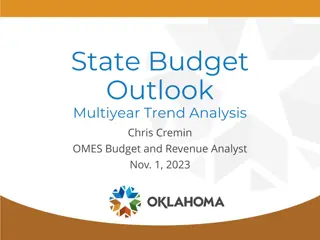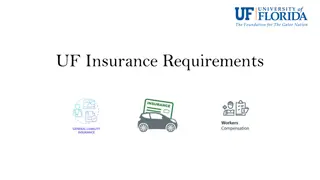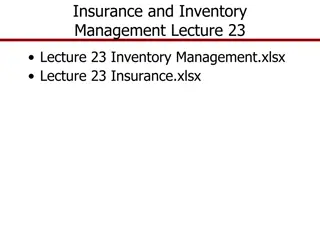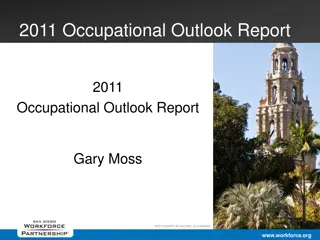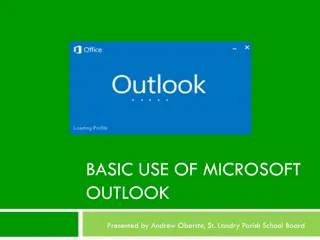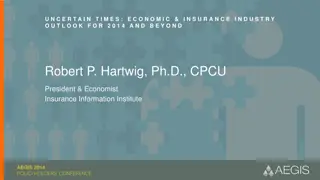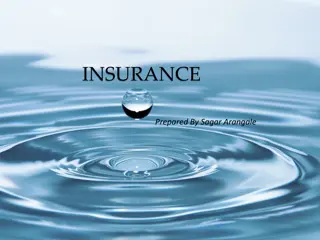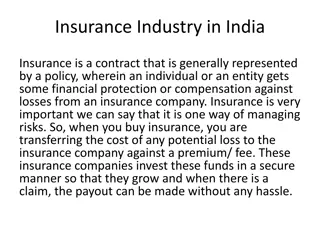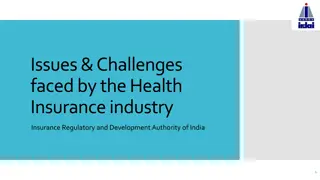Analysis of P/C Insurance Industry Trends and Outlook
The Property/Casualty (P/C) insurance industry has seen three consecutive years of growth from 2013-2015, with a potential continuation in 2016. Net premium growth rates, catastrophic losses, and combined ratio points associated with catastrophe losses are key indicators examined in this overview. Despite challenges like declining written premiums and increasing catastrophe losses, the industry remains resilient. Insights from the presentation by Steven N. Weisbart, Senior Vice President and Chief Economist of the Insurance Information Institute, shed light on the industry's performance and outlook.
Download Presentation

Please find below an Image/Link to download the presentation.
The content on the website is provided AS IS for your information and personal use only. It may not be sold, licensed, or shared on other websites without obtaining consent from the author. Download presentation by click this link. If you encounter any issues during the download, it is possible that the publisher has removed the file from their server.
E N D
Presentation Transcript
P/C Insurance Industry Overview & Outlook PCICS Summer Meeting Minneapolis, MN August 22, 2016 Steven N. Weisbart, Ph.D., CLU, Senior Vice President & Chief Economist Insurance Information Institute 110 William Street New York, NY 10038 Tel: 212.346.5540 Cell: 917.494.5945 stevenw@iii.org www.iii.org
First, the Good News about the P/C Insurance Industry: 2013-15 Were Three Good Years in a Row 2016 Could Keep the String Going 2 2
Net Premium Growth: Annual Change, 1971 2016F 16 Years? 16 Years 2016-19 1975-78 1984-87 2000-03 25% Net Written Premiums Fell 0.7% in 2007 (First Decline Since 1943) by 2.0% in 2008, and 4.2% in 2009, the First 3- Year Decline Since 1930-33. 20% 15% 2016F: 4.5% 2015: 3.4% 2014: 4.2% 2013: 4.6% 2012: 4.3% 10% 5% 0% -5% 71 72 73 74 75 76 77 78 79 80 81 82 83 84 85 86 87 88 89 90 91 92 93 94 95 96 97 98 99 00 01 02 03 04 05 06 07 08 09 10 11 12 13 14 15 16 Shaded areas denote hard market periods Sources: A.M. Best (historical and forecast), ISO, Insurance Information Institute. 3
U.S. Insured Catastrophe Losses ($ Billions, $ 2015) 2012 was the 3rd most expensive year ever for insured CAT losses $80 $75.7 $70 $60 $38.9 $50 $36.1 $35.8 $34.7 $34.6 $30.1 $40 $27.2 $30 $16.8 $15.5 $15.2 $14.8 $14.9 $14.4 $13.0 $13.1 $11.9 $11.8 $11.3 $10.9 $20 $9.1 $8.2 $7.8 $7.7 $6.3 $5.0 $3.9 $10 $0 89 90 91 92 93 94 95 96 97 98 99 00 01 02 03 04 05 06 07 08 09 10 11 12 13 14 15 2013/14/15 were welcome respites from 2011/12 the latter being among the costliest years for insured disaster losses in US history. The longer-term trend is for more costly events. *Estimate through 12/31/15 in 2015 dollars. Note: 2001 figure includes $20.3B for 9/11 losses reported through 12/31/01 ($25.9B 2011 dollars). Includes only business and personal property claims, business interruption and auto claims. Non-prop/BI losses = $12.2B ($15.6B in 2011 dollars.) Sources: Property Claims Service/ISO; Insurance Information Institute. 4 4
Combined Ratio Points Associated with Catastrophe Losses: 1960 2015E* Catastrophe losses as a share of all losses reached a record high in 2011 Combined Ratio Points Avg. CAT Loss Component of the Combined Ratio by Decade 12 9.6 10 1960s: 1.04 1970s: 0.85 1980s: 1.31 1990s: 3.39 2000s: 3.52 2010s: 5.46* 8.8 8.1 8.0 8 5.9 5.4 6 5.0 4.6 4.0 3.1 3.6 3.6 3.5 4 3.3 3.3 3.3 3.0 2.9 2.8 2.7 2.6 2.3 1.22.1 2.0 2.0 1.8 1.6 1.6 1.6 1.5 1.4 2 1.3 1.3 1.2 1.1 1.1 1.1 1.0 1.0 0.9 0.8 0.8 0.7 0.7 0.7 0.6 0.5 0.5 0.4 0.4 0.4 0.4 0.4 0.3 0.1 0 1960 1962 1964 1966 1968 1970 1972 1974 1976 1978 1980 1982 1984 1986 1988 1990 1992 1994 1996 1998 2000 2002 2004 2006 2008 2010 2012 2014 The Catastrophe Loss Component of Private Insurer Losses Has Increased Sharply in Recent Decades *2010s represent 2010-2015E. Notes: Private carrier losses only. Excludes loss adjustment expenses and reinsurance reinstatement premiums. Figures are adjusted for losses ultimately paid by foreign insurers and reinsurers. Source: ISO (1960-2009); A.M. Best (2010-15E) Insurance Information Institute. 5
P/C Insurance Industry Combined Ratio, 2001 2015* Insurers Paid Nearly $1.16 for Every $1 in Earned Premiums Higher CAT Losses, Shrinking Reserve Releases, Toll of Soft Market 120 115.8 Best Combined Ratio Since 1949 (87.6) 110 107.5 106.3 102.4 101.0 100.8 100.8 100.1 100 99.3 98.4 97.8 97.2 96.7 95.7 92.6 06 90 01 02 03 04 05 07 08 09 10 11 12 13 14 15 Heavy Use of Reinsurance Lowered Net Losses * Excludes Mortgage & Financial Guaranty insurers 2008--2014. Including M&FG, 2008=105.1, 2009=100.7, 2010=102.4, 2011=108.1; 2012:=103.2; 2013: = 96.1; 2014: = 97.0. Sources: A.M. Best, ISO. 6
P/C Industry Net Income After Taxes 1991 2015 2006 ROE = 12.7% 2007 ROE = 10.9% 2008 ROE = 0.1% 2009 ROE = 5.0% 2010 ROE = 6.6% 2011 ROAS1 = 3.5% 2012 ROAS1 = 5.9% 2013 ROAS1 = 10.2% 2014 ROAS1 = 8.4% 2015:ROAS = 8.4% $ Millions $80,000 $65,777 $63,784 $62,496 $56,600 $70,000 $55,501 $60,000 $44,155 $38,501 $36,819 $50,000 $35,204 $33,522 $30,773 $30,029 $28,672 $40,000 $24,404 $21,865 $20,598 $20,559 $19,456 $19,316 $30,000 $14,178 $10,870 $20,000 $5,840 $3,046 $3,043 $10,000 $0 -$6,970 -$10,000 91 92 93 94 95 96 97 98 99 00 01 02 03 04 05 06 07 08 09 10 11 12 13 14 15 ROE figures are GAAP; 1Return on avg. surplus. Excluding Mortgage & Financial Guaranty insurers yields a 8.2% ROAS in 2014, 9.8% ROAS in 2013, 6.2% ROAS in 2012, 4.7% ROAS for 2011, 7.6% for 2010 and 7.4% for 2009. Sources: A.M. Best, ISO; Insurance Information Institute.
Profitability Peaks & Troughs in the P/C Insurance Industry, 1975 2016F ROE History suggests next ROE peak will be in 2016-2017, but that seems unlikely 1977:19.0% 1987:17.3% 25% 20% 2006:12.7% 1997:11.6% 2013 9.8% 15% 2015=8.4% 2016F=6.3% 9 Years 10% 5% 2014 8.4% 0% 2001: -1.2% 1975: 2.4% 1984: 1.8% 1992: 4.5% -5% 75 76 77 78 79 80 81 82 83 84 85 86 87 88 89 90 91 92 93 94 95 96 97 98 99 00 01 02 03 04 05 06 07 08 09 10 11 12 13 14 15 16 *Profitability = P/C insurer ROEs. 2011-14 figures are estimates based on ROAS data. Note: Data for 2008-2014 exclude mortgage and financial guaranty insurers. Source: Insurance Information Institute; NAIC, ISO, A.M. Best, Conning
Return on Net Worth (RNW) Largest Lines: 2005-2014 Average Commercial lines have tended to be more profitable than personal lines over the past decade Percent 15.6 16 12.8 11.9 12 8.0 8 6.9 6.7 6.4 6.3 6.2 3.8 4 2.8 2.2 0 Comm Auto Other Liability A & H PP Auto Total Commercial Farm MP Homeowners Allied Lines Workers Fire Inland Marine Med Prof Liab Comp Total MP MP Source: NAIC; Insurance Information Institute. 9
RNW All Lines, 2005-2014 Average, Vary Widely by State and Region Mountain Southwest Far West Great Plains Great Lakes 13.2% 15% 11.9% 11.5% 11.3% 11.0% 10.6% 10.5% 10.0% 8.9% 8.8% 10% 8.3% 7.8% 7.5% 7.5% 7.4% 7.3% 7.3% 7.1% 7.0% 6.9% 6.8% 6.3% 6.1% 3.4% 5% 1.7% 0% AZ NE OK OR OH MN ID CA IN ND SD IA MO CO MT UT IL NM WY TX NV KS MI WA WI Sources: NAIC; Insurance Information Institute 10
RNW All Lines, 2005-2014 Average, Vary Widely by State and Region 19.9% 25.0% 19.0% Southeast Mid-Atlantic New England 20.0% 14.0% 13.3% 13.0% 11.7% 11.7% 11.1% 10.9% 10.8% 10.6% 15.0% 9.9% 9.6% 8.9% 7.8% 7.1% 6.5% 6.2% 10.0% 5.5% 5.1% 5.1% 4.7% 4.1% 5.0% 0.0% -5.0% -7.4% -10.0% -9.4% LA -15.0% ME KY NY DE GA MD MA VA NC SC AR TN PA NH AK NJ FL AL VT CT MS RI HI WV Sources: Sources: NAIC; Insurance Information Institute. 11
Policyholder Surplus, 2006:Q4 2016:Q1 ($ Billions) $750 Drop due to near-record 2011 CAT losses 2007:Q3 Pre-Crisis Peak $676.3 $673.9 $674.7 $673.7 $672.4 $671.6 $671.7 $662.0 $700 $663.9 $653.4 $624.4 $650 $614.0 $607.7 $586.9 $583.5 $566.5 $570.7 $600 $567.8 $559.2 $559.1 $550.3 $544.8 $540.7 $538.6 $530.5 $521.8 $550 $517.9 $515.6 $512.8 $511.5 $505.0 $496.6 $490.8 $487.1 $478.5 $500 $463.0 $455.6 Surplus as of 3/31/16 stood at $676.3B $437.1 $450 $400 06:Q4 07:Q1 07:Q2 07:Q3 07:Q4 08:Q1 08:Q2 08:Q3 08:Q4 09:Q1 09:Q2 09:Q3 09:Q4 10:Q1 10:Q2 10:Q3 10:Q4 11:Q1 11:Q2 11:Q3 11:Q4 12:Q1 12:Q2 12:Q3 12:Q4 13:Q1 13:Q2 13:Q3 13:Q4 14:Q1 14:Q2 14:Q3 14:Q4 15:Q1 15:Q2 15:Q3 15:Q4 16:Q1 The industry now has $1 of surplus for every $0.77 of NPW, close to the strongest claims-paying status in its history. 2010:Q1 data includes $22.5B of paid-in capital from a holding company parent for one insurer s investment in a non- insurance business. The P/C insurance industry entered 2016 in very strong financial condition. Sources: ISO, A.M .Best. 12
Modest Economic Growth in 2016-17 Should Increase the Exposure Base and Premium Volume Both Commercial and Personal Lines Should Benefit 13 13
Real U.S. Quarterly GDP Growth Since the Great Recession 5% Advance estimate 4% 3% 5.0% 4.6% 4.0% 4.0% 3.9% 3.9% 3.5% 2% 3.1% 2.9% 2.8% 2.7% 2.6% 2.5% 2.5% 2.3% 2.3% 2.0% 2.0% 1.7% 1.6% 1% 1.3% 1.2% 0.9% 0.8% 0.8% 0.8% 0.1% 0% -1.2% -1.5% -1% GDP now estimate as of August 12 -2% 09:3Q 09:4Q 10:1Q 10:2Q 10:3Q 10:4Q 11:1Q 11:2Q 11:3Q 11:4Q 12:1Q 12:2Q 12:3Q 12:4Q 13:1Q 13:2Q 13:3Q 13:4Q 14:1Q 14:2Q 14:3Q 14:4Q 15:1Q 15:2Q 15:3Q 15:4Q 16:1Q 16:2Q 16:3Q Since the Great Recession ended, even 3% real growth (at an annual rate) in a quarter has been unusual. Through 2016:Q2, it happened only 7 times in 28 quarters and not once in the most recent 7 quarters. Data are quarterly changes at annualized rates. Sources: US Department of Commerce, at http://www.bea.gov/national/index.htm#gdp ; Insurance Information Institute. 14
Length of US Business Cycles, 1929 Present* When Will the Next Recession Start? 2018? Length of Expansions Greatly Exceeds Contractions Duration (Months) 120 120 Contraction Expansion Following 106 110 Average Duration** Recession = 10.4 Mos Expansion = 60.5 Mos 100 92 86 90 80 80 73 70 58 60 50 45 50 43 39 37 36 40 24 30 19 16 16 20 13 12 11 11 10 10 8 8 8 8 6 10 0 Aug 1929 May 1937 Feb 1945 Nov 1948 Jul 1953 Aug 1957 Apr 1960 Dec 1969 Nov 1973 Jan 1980 Jul 1981 Jul 1990 Mar 2001 Dec 2007 Month Recession Started *Through August 2016. ** Post-WW II period through end of 2001-2007 expansion. Sources: National Bureau of Economic Research; Insurance Information Institute. 15
GDP-based Recession-Indicator Index, with data through 2016:Q1 Index NBER-dated recessions tend to follow when the Index reaches 40% Likelihood of a recession remains low (15.7%) The plotted value for each date is based solely on information as it would have been publicly available and reported as of one quarter after the indicated date, with 2015:Q4 the last date shown on the graph. Shaded regions represent NBER-dated recessions; which were sometimes not reported until two years after a recession was determined to have ended, and were not used in any way in constructing the index. Source: https://www.frbatlanta.org/cqer/research/gdpbased_RII.aspx (updated May 11, 2016); I.I.I. 16
Quarterly US Real GDP for 2016-17: August 2016 Forecasts Real GDP Growth Rate (%) 10 Most Pessimistic Median 10 Most Optimistic 4 3.8 3.75 3.5 3.25 3 2.8 2.8 2.75 2.6 2.6 2.6 2.5 2.5 2.3 2.3 2.2 2.2 2.25 2.1 2.1 2 1.8 1.8 1.7 1.7 1.75 1.6 1.5 2016:Q3 2016:Q4 2017:Q1 2017:Q2 2017:Q3 2017:Q4 Many of the 53 forecasts in the Blue Chip survey expect good growth in the third quarter of 2016 and slower growth in 2017. Sources: Blue Chip Economic Indicators (8/16); Insurance Information Institute 17
State-by-State Leading Indicators through December 2016 Near-term growth forecasts vary widely by state. Strongest growth = dark green (1.5%-4.5%); then light green; then gray; weakest = red Sources: Federal Reserve Bank of Philadelphia at www.philadelphiafed.org/index.cfm , released August 1, 2016; Insurance Information Institute. Next release is August 29, 2016 18
Nonfarm Employment, Quarterly Change, 2011 2016* Thousands 846 900 834 829 823 765 752 800 736 654 700 636 627 594 587 576 570 556 555 600 525 524 514 460 455 500 423 400 277 300 200 100 0 2011:Q1 2011:Q2 2011:Q3 2011:Q4 2012:Q1 2012:Q2 2012:Q3 2012:Q4 2013:Q1 2013:Q2 2013:Q3 2013:Q4 2014:Q1 2014:Q2 2014:Q3 2014:Q4 2015:Q1 2015:Q2 2015:Q3 2015:Q4 2016:Q1 2016:Q2 2016:Q3 * After a strong 2014-15, the pace of job growth has slowed somewhat. *Seasonally adjusted; 2016:Q3 is July projected to the full quarter. June and July 2016 data are preliminary Sources: US Bureau of Labor Statistics; Insurance Information Institute 19
Unemployment and Underemployment Rates: Still Falling January 2000 through July 2016, Seasonally Adjusted (%) U-6 went from 8.0% in March 2007 to 17.5% in October 2009 18 "Headline" Unemployment Rate U-3 16 Unemployment + Underemployment Rate U-6 14 For U-6, 8.0% to 9.5% is normal. 12 U-6 was 9.7% in July 2016. 10 8 Headline unemployment was 4.9% in July 2016. 4.5% to 5.5% is normal. 6 4 2 Jan 00 Jan 01 Jan 02 Jan 03 Jan 04 Jan 05 Jan 06 Jan 07 Jan 08 Jan 09 Jan 10 Jan 11 Jan 12 Jan 13 Jan 14 Jan- 15 Jan- 16 Based on the latest readings, it appears that the job market is now close to normal Source: US Bureau of Labor Statistics; Insurance Information Institute. 20 20
Labor Market Slack: Elevated Number of Involuntary Part-time Workers July 2016: 5.94 million In less than 18 months, 4.5 million additional people were involuntarily working part time The normal range (since 1992) 21
Number of Discouraged Workers: Elevated, but Dropping Jan 1994 July 2016 Thousands A discouraged worker in a month did not actively look for work in the prior month for reasons such as --thinks no work available, --could not find work, --lacks schooling or training, --thinks employer thinks too young or old, and other types of discrimination. Latest reading: 591,000 in July 2016. 1,400 1,300 1,200 1,100 1,000 900 800 700 600 500 400 300 200 Normal 100 0 '94 In recent good times, the number of discouraged workers ranged from 200,000-400,000 (1995-2000) or from 300,000-500,000 (2002-2007). '97 '00 '03 '07 '10 '13 Notes: Recessions indicated by gray shaded columns. Data are seasonally adjusted. Sources: Bureau of Labor Statistics; National Bureau of Economic Research (recession dates). 22
Full-time vs. Part-time Employment, Quarterly, 2003-2016:Q2 Part-time, millions Full time, millions Full-time Part-time Recession New full-time peak 124 28.5 Pre-recession, most new jobs were full-time 28.0 122 27.5 120 27.0 Recession shifted employment growth from full- time to part-time 118 26.5 26.0 116 25.5 114 25.0 112 24.5 110 24.0 2003.1 2003.2 The Great Recession shifted employment from full-time to part-time. Full-time employment is finally above its pre-recession peak, but part-time hasn t receded. 2003.3 2003.4 2004.1 2004.2 2004.3 2004.4 2005.1 2005.2 2005.3 2005.4 2006.1 2006.2 2006.3 2006.4 2007.1 2007.2 2007.3 2007.4 2008.1 2008.2 2008.3 2008.4 2009.1 2009.2 2009.3 2009.4 2010.1 2010.2 2010.3 2010.4 2011.1 2011.2 2011.3 2011.4 2012.1 2012.2 2012.3 2012.4 2013.1 2013.2 2013.3 2013.4 2014.1 2014.2 2014.3 2014.4 2015.1 2015.2 2015.3 2015.4 2016.1 2016.2 Data are seasonally-adjusted. Sources: US Bureau of Labor Statistics, US Department of Labor; Insurance Information Institute.
ISM Manufacturing Index (Values > 50 Indicate Expansion), January 2010-July 2016 As of July, 5 Consecutive Months of Expansion Index 65 61.4 60.8 60.4 59.7 59.7 59.6 55.357.159.0 59.0 58.7 58.5 58.3 60 58.2 57.8 57.1 57.0 55.356.9 56.6 56.5 56.4 56.2 54.255.8 55.7 55.5 55.4 55.4 55.3 55.2 55.1 54.9 54.2 54.1 54.1 53.7 53.5 53.5 53.3 55 51.353.2 51.353.2 53.1 53.1 52.9 52.8 52.7 52.6 52.5 52.5 52.5 52.2 51.9 51.8 51.8 51.7 51.6 51.5 51.5 51.4 51.3 51.1 50.9 50.8 50.7 50.7 50.5 50.2 50.2 50.2 50.1 50 49.9 49.5 49.0 48.6 48.2 48.0 45 Jan 10 Jan 11 Jan 12 Jan 13 Jan 14 Jan 15 Jan 16 Jul 10 Jul 11 Jul 12 Jul 13 Jul 14 Jul 15 Jul 16 The Manufacturing Sector Expanded for 68 of the 72 Months from January 2010 Through December 2015. Manufacturing Contracted in 2015:Q4 and 2016:Q1 but is Expanding Again. Sources: Institute for Supply Management; Insurance Information Institute.
ISM Non-Manufacturing Index (Values > 50 Indicate Expansion), January 2010-July 2016 Index 62 59.6 59.3 58.3 58.3 58.0 57.9 59 57.5 57.3 57.3 57.2 57.1 57.0 56.9 56.9 56.9 56.7 56.7 56.7 56.7 56.6 56.5 56.3 56.3 56.2 56.0 55.9 55.8 55.8 55.7 54.555.7 55.6 55.6 55.5 55.5 55.5 55.5 55.3 55.3 55.2 55.1 55.1 55.1 55.0 55.0 54.8 56 54.7 54.6 54.6 54.5 54.4 54.4 54.3 54.2 54.1 54.1 54.0 53.9 53.8 53.8 53.8 53.6 53.6 53.6 53.5 53.4 53.4 53.2 53.1 53.0 52.9 52.8 52.8 52.7 52.6 52.4 52.4 53 50.8 50 49.6 47 Jan 10 Jan 11 Jan 12 Jan 13 Jan 14 Jan 15 Jan 16 Jul 10 Jul 11 Jul 12 Jul 13 Jul 14 Jul 15 Jul 16 The Non-Manufacturing (Services) Sector Expanded in Every Month After January 2010. Compared to 2014-15, the Pace of Expansion Has Slowed in 2016 But Not Ended. Sources: Institute for Supply Management via https://research.stlouisfed.org/fred2/data/NMFCI.txt; Insurance Information Institute.
Forces Affecting Personal Lines: Auto Insurance 30
Return on Net Worth: Personal Auto, 2005 2014 18% Personal Auto Fortune 500 16% 14.3% 14% 12% 10% 8% 6% 4.3% 4% 2% 0% 2005 2006 2007 2008 2009 2010 2011 2012 2013 2014 Auto Insurance Profitability Has Been Stuck at Low Levels. Source: National Association of Insurance Commissioners.
Auto Insurance Net Combined Ratios, Yearly, 2005-2015 115% 108.8% 107.0% 106.9% 110% 104.6% 103.6% 103.4% 102.5% 102.1% 102.0% 101.6% 101.3% 101.0% 105% 100.2% 100% 99.5% 98.3% 98.1% 96.8% 95% 95.6% 95.1% 94.3% 92.5% 92.1% 90% Commercial Personal 85% 2005 2006 2007 2008 2009 2010 2011 2012 2013 2014 2015 Loss Ratios Have Been Rising for A Decade. 2015 Return on Net Worth Is Likely Close to Zero or Negative. Sources: National Association of Insurance Commissioners data, sourced from S&P Global Market Intelligence; Insurance Information Institute.
A Half Century of Auto Insurance: Frequency vs. Severity In the Long Run, Frequency Falls. Severity Increases. Frequency Severity 18,000 9.0 7.92 Claims per 100 Insured Vehicles $15,443 16,000 8.0 14,000 Claim Severity 7.0 12,000 6.0 5.0 10,000 4.22 $7,553 4.0 8,000 3.55 3.0 6,000 2.61 2.0 4,000 $3,231 1.23 0.95 1.0 2,000 $1,288 $1,143 $183 0.0 0 Property Damage Bodily Injury Property Damage Bodily Injury 1963 1988 2013 Sources: Insurance Institute for Highway Safety, Insurance Services Office, Insurance Information Institute.
Why Personal Auto Loss Ratios are Rising: Severity & Frequency by Coverage, 2015 vs. 2014 Annual Change, 2015 Over 2014 12% Severity Frequency 10.2% 10% 8% 6.4% 5.7% 6% 4.1% 3.5% 4% 2.2% 2% 1.1% 0.8% 0% -2% -1.7% -2.5% -4% Bodily Injury Property Damage Liability PIP Collision Comprehensive Across All Personal Coverage Types (Except Comprehensive) in 2015, Frequency and Severity Rose. This Pattern is Likely to Continue in 2016. Source: ISO/PCI Fast Track data; Insurance Information Institute.
Auto/Light Truck Sales Are Forecast to Continue in 2016 at the 2015 Level (Millions of Units) We re back to new vehicle sales levels last seen pre-recession 19 17.8 17.5 17.4 17.3 17.1 17.2 17.2 17.2 17.1 16.9 16.9 16.6 16.5 16.4 16.1 17 15.5 14.4 15 13.2 12.7 13 11.6 10.4 11 9 99 00 01 02 03 04 05 06 07 08 09 10 11 12 13 14 15 16F17F18F19F Yearly car/light truck sales will likely continue at current levels, in part replacing cars that were held onto in 2008-12. But rising interest rates could eventually restrain demand for new vehicles. Sources: US Department of Commerce; Blue Chip Economic Indicators, 8/16 issue (forecasts); Insurance Information Institute. 35
America is Driving More Again: Total Miles Driven*, 1996 2016 Billions 3,200 driven rose virtually every month, even through recessions. From 1996 (and well before), miles New miles driven records in 2016 3,100 3,000 2,900 2,800 2,700 From November 2007 until January 2015, miles driven was below the prior peak for 87 straight months over 7 years! Previous record (below prior peak( was in the early 1980s (39 months). 2,600 2,500 2,400 '96 '97 '98 '99 '00 '01 '02 '03 '04 '05 '06 '07 '08 '09 '10 '11 '12 '13 '14 '15 '16 *Moving 12-month total. The data are through May 2016, the latest available. Note: Recessions indicated by gray shaded columns. Sources: Federal Highway Administration (http://www.fhwa.dot.gov/policyinformation/travel_monitoring/tvt.cfm ); National Bureau of Economic Research (recession dates); Insurance Information Institute. 36
Why Are We Driving More Miles? More Are Going to Work Billions of Miles Driven in Prior Year (as of Quarter-End) Millions Employed Miles Driven (left axis) 3,200 145.0 Recession # Employed (right axis) 142.5 3,150 140.0 3,100 137.5 3,050 135.0 3,000 132.5 2,950 130.0 2,900 127.5 06:Q1 06:Q3 07:Q1 07:Q3 08:Q3 09:Q1 09:Q3 10:Q1 10:Q3 11:Q1 11:Q3 12:Q1 12:Q3 13:Q1 13:Q3 14:Q1 14:Q3 15:Q1 15:Q3 16:Q1 08:Q1 Most Employed People Drive to and from Work, but when They re Not Employed, They Drive Less (and not During Rush Hour ) Sources: Federal Highway Administration (http://www.fhwa.dot.gov/policyinformation/travel_monitoring/tvt.cfm); Seasonally Adjusted Nonfarm Employed from Bureau of Labor Statistics; Insurance Information Institute.
More Miles Driven => More Collisions, 2006 2016 Billions of Miles Driven in Prior Year Overall Collision Claims Per 100 Insured Vehicles Miles Driven (left axis) Collision Claim Frequency (right axis) 3200 6.0 3150 Recession 5.9 3100 3050 5.8 3000 5.7 2950 2900 5.6 2850 2800 5.5 06:Q1 06:Q3 07:Q1 07:Q3 08:Q1 08:Q3 09:Q1 09:Q3 10:Q1 10:Q3 11:Q1 11:Q3 12:Q1 12:Q3 13:Q1 13:Q3 14:Q1 14:Q3 15:Q1 15:Q3 16:Q1 The more miles people drive, the more likely they are to get in an accident, helping drive claim frequency higher. Sources: Federal Highway Administration (http://www.fhwa.dot.gov/policyinformation/travel_monitoring/tvt.cfm ); Rolling Four-Qtr Avg. Frequency from Insurance Services Office; Insurance Institute for Highway Safety; Insurance Information Institute. 38
Forces Affecting Personal Lines: Home Insurance 42
Forecast: Continued Growth in Private Housing Unit Starts, 1995-2019F Rising mortgage rates could dampen the demand for new residential construction (Millions of Units) 2.1 2.07 1.96 1.85 1.80 1.9 1.71 1.64 1.62 1.60 1.57 1.7 1.48 1.47 1.46 1.43 1.35 1.36 1.5 1.31 1.19 1.3 1.11 1.00 1.1 0.92 0.91 0.78 0.9 Housing unit starts plunged 72% from 2005- 2009, down 1.49 million, to lowest level since records began in 1959 0.61 0.59 0.55 0.7 0.5 0.3 95 96 97 98 99 00 01 02 03 04 05 06 07 08 09 10 11 12 13 14 15 16F 17F 18F 19F Housing starts are climbing slowly. Recently, the fastest growth is in multi- unit residences. Personal lines exposure will grow, and commercial insurers with Workers Comp, Construction risk exposure and Surety also benefit. Sources: US Department of Commerce (history); Blue Chip Economic Indicators (8/2016), forecasts; Insurance Information Institute. 43
Number of Owner-Occupied & Renter-Occupied Housing Units, US, Quarterly, 1990:Q1-2016:Q2 Millions of Owner- Occupied Housing Units Millions of Renter- Occupied Housing Units Number of renter-occupied housing units Number of owner-occupied housing units 46 77 Number of owner-occupied units has been stuck at roughly 75 million units since 2005:Q4 75 44 73 42 71 69 40 67 Trough in 2004:Q2 at 32.61 million units. 38 65 63 36 Latest renter-occupied was 43.86 million units in 2016:Q2. 61 34 59 32 57 93:Q1 Since 2004 the number of renter-occupied housing units has grown by over 10 million units (+31.4%), but there has been no growth in the number of owner- occupied housing units in over 10 years. When will this end? 90:Q1 91:Q1 92:Q1 94:Q1 95:Q1 96:Q1 97:Q1 98:Q1 99:Q1 00:Q1 01:Q1 02:Q1 03:Q1 04:Q1 05:Q1 06:Q1 07:Q1 08:Q1 09:Q1 10:Q1 11:Q1 12:Q1 13:Q1 14:Q1 15:Q1 16:Q1 Sources: US Census Bureau at http://www.census.gov/housing/hvs/data/histtabs.html , Table 3; Insurance Information Institute. 44 44
Rental Vacancy Rates, Quarterly, 1990-2016 Percent vacant Peak vacancy rate 11.1% in 2009:Q3 11.5 Latest vacancy rate was 6.7% in 2016:Q2 11.0 10.5 Vacancy rate 10.4% in 2004:Q1 10.0 9.5 9.0 8.5 8.0 7.5 7.0 6.5 90:Q1 Before the 2001 recession, rental vacancy rates were 8% or less. We re below those levels now. => More multi-unit construction? 91:Q1 92:Q1 93:Q1 94:Q1 95:Q1 96:Q1 97:Q1 98:Q1 99:Q1 00:Q1 01:Q1 02:Q1 03:Q1 04:Q1 05:Q1 06:Q1 07:Q1 08:Q1 09:Q1 10:Q1 11:Q1 12:Q1 13:Q1 14:Q1 15:Q1 16:Q1 Sources: US Census Bureau, Residential Vacancies & Home Ownership in the Second Quarter of 2016 and earlier issues; Insurance Information Institute. 45 45
US: Pct. Of Private Housing Unit Starts In Multi-Unit Projects, 1990-2016* Units in Multiple-Unit Projects as Percent of Total 40% A NEW NORMAL? In 7 of the last 9 years, over 30% of housing unit starts were in 5+- unit projects 36.0% 35.0% 33.3% 32.5% 30% 31.4% 31.3% 29.3% 25.0% 23.1% 22.8% 20% 21.5% 21.4% 21.4% 20.6% 20.6% 20.5% 20.3% 19.7% 19.7% 18.9% 18.6% 17.7% 17.7% 17.1% 17.0% 14.2% 12.6% 10% 0% 90 91 92 93 94 95 96 97 98 99 00 01 02 03 04 05 06 07 08 09 10 11 12 13 14 15 16* For the U.S. as a whole, the trend toward multi-unit housing projects (vs. single-unit homes) is recent. Commercial insurers with Workers Comp, Construction risk exposure, and Surety benefit. *through July 2016 Based on seasonally-adjusted data. Sources: U.S. Census Bureau; Insurance Information Institute calculations. 46
I.I.I. Poll: Renters Insurance Percentage of Renters Who Have Renters Insurance, 2011-2015 100% 90% 80% 70% 60% 50% 41% 40% 37% 35% 40% 31% 29% 30% 20% 10% 0% May 2011 May 2012 May 2013 May 2014 May 2015 May-16 The Percentage Of Renters With Renters Insurance Has Been Growing, But Slowly Source: Insurance Information Institute Annual Pulse Survey. 47
Giant Age Cohort (Millenials) Is Approaching Home-Buying Stage Number of People in 2015 (Millions) Average Age, 1st Time Homebuyer 5.00 Millennial Generation Average Age, Repeat Homebuyer 4.784.77 4.69 4.75 4.57 4.58 4.50 4.48 4.404.414.44 4.50 4.40 4.39 4.304.364.354.30 4.224.254.30 4.25 4.12 4.033.99 4.00 3.87 3.75 18 19 20 21 22 23 24 25 26 27 28 29 30 31 32 33 34 35 36 37 38 39 40 If prior patterns hold, the number of homes bought by current renters, and the number of new homes built, will rise in coming years Sources: Census Bureau; CoreLogic; Insurance Information Institute. 48
Private Nonresidential Fixed Investment, Quarterly: Recently, a New Peak $ Billions* 2016:Q2 at $2167.3 B 2,300 2,200 Recession 2,100 2,000 1,900 1,800 Many economists expect business investment to rise in 2016 1,700 1,600 1,500 1,400 1999:Q1 2000:Q1 2006:Q1 2012:Q1 2013:Q1 2001:Q1 2002:Q1 2003:Q1 2004:Q1 2005:Q1 2007:Q1 2008:Q1 2009:Q1 2010:Q1 2011:Q1 2014:Q1 2015:Q1 2016:Q1 This is a measure of the growth of the commercial property exposure base. Business investment dipped in 2016:1H but is expected to grow slowly in 2016:2H. If so, commercial insurance premium volume will grow with it. *Quarterly, at seasonally adjusted annual rate Sources: Federal Reserve Board at http://research.stlouisfed.org/fred2/data/PNFIC96.txt . National Bureau of Economic Research (recession dates); Insurance Information Institutes. 51 51
Nonfarm Payroll (Wages and Salaries): Quarterly, 2005 2016:Q1 Billions $8,250 Latest (2016:Q2) was $8.06 trillion, a new peak--$1.84T above 2009 trough $8,000 Prior Peak was 2008:Q3 at $6.54 trillion $7,750 $7,500 $7,250 $7,000 $6,750 $6,500 Growth rates 2011:Q1 over 2010:Q1: 5.5% 2012:Q1 over 2011:Q1: 4.2% 2013:Q1 over 2012:Q1: 2.5% 2014:Q1 over 2013:Q1: 4.3% 2015:Q1 over 2014:Q1: 4.4% 2016:Q1 over 2015:Q1: 4.5% $6,250 $6,000 Recent trough (2009:Q1) was $6.23 trillion, down 5.3% from prior peak $5,750 $5,500 05:Q1 05:Q2 05:Q3 05:Q4 06:Q1 06:Q2 06:Q3 06:Q4 07:Q1 07:Q2 07:Q3 07:Q4 08:Q1 08:Q2 08:Q3 08:Q4 09:Q1 09:Q2 09:Q3 09:Q4 10:Q1 10:Q2 10:Q3 10:Q4 11:Q1 11:Q2 11:Q3 11:Q4 12:Q1 12:Q2 12:Q3 12:Q4 13:Q1 13:Q2 13:Q3 13:Q4 14:Q1 14:Q2 14:Q3 14:Q4 15:Q1 15:Q2 15:Q3 15:Q4 16:Q1 16:Q2 Note: Recession indicated by gray shaded column. Data are seasonally adjusted annual rates. Sources: http://research.stlouisfed.org/fred2/series/WASCUR; National Bureau of Economic Research (recession dates); Insurance Information Institute. 52 52
Inflation & Claims Overall Inflation Has Been Low, but Prices for Some Items that Affect Claims Are Rising Notably Faster 53 53
Change* in the Consumer Price Index, 2004 2016 For two months in 2008, led by gasoline, the general price level was rising at a 5.5% pace 7% Recession CPI 6% Lately, the CPI is rising at a 1.0% y-o-y pace 5% 4% 3% 2% 1% 0% -1% When gas prices dropped, the general price level was briefly lower than a year prior -2% -3% '04 '05 '06 '07 '08 '09 '10 '11 '12 '13 '14 '15 '16 Over the last decade, prices generally rose about 2% per year. *Monthly, year-over-year, through June 2016. Not seasonally adjusted. Sources: US Bureau of Labor Statistics; National Bureau of Economic Research (recession dates); Insurance Information Institutes. 54 54
Change* in the Consumer Price Index, 2004 2016 7% Since 2004, the core CPI never rose faster than a 3% y-o-y pace Recession CPI Core CPI 6% Lately, core CPI is rising at a 2.3% y-o-y pace 5% 4% 3% 2% 1% 0% -1% The core CPI continuously rose; for a few months, the rate of increase was under 1% -2% -3% '04 '05 '06 '07 '08 '09 '10 '11 '12 '13 '14 '15 '16 Over the last decade, prices generally rose about 2% per year. *Monthly, year-over-year, through June 2016. Not seasonally adjusted. Sources: US Bureau of Labor Statistics; National Bureau of Economic Research (recession dates); Insurance Information Institutes. 55 55
Prices for Hospital Services: 12-Month Change,* 1998 2016 June 2016 14% Inpatient services +5.1% 12% 10% 8% 6% 4% June 2016 2% Outpatient services +2.3% 0% '98 '01 '04 '07 '11 '14 Recession Outpatient Services Inpatient Services Prices for Hospital Services have risen at an annual rate of 4% (and often more) for the last 15 years, while the general price level rose by 2%/year. *Percentage change from same month in prior year; through June 2016; seasonally adjusted Sources: US Bureau of Labor Statistics; National Bureau of Economic Research (recession dates); Insurance Information Institute. 56
Investment Performance: a Key Driver of Profitability Depressed Yields Influence Underwriting & Pricing 57 57
US Treasury Note 10-Year Yields: A Long Downward Trend, 2000 2016* 7% Yields on 10-Year US Treasury Notes have been below 3% for 5 years: bonds bought in 2006 at 5% will be reinvested at 1.5% for 10 more years 6% 5% 4% 3% US Treasury yields plunged to historic lows in 2013, then rebounded but are sinking again 2% Recession 1% 10-Yr Yield 0% '00 '01 '02 '03 '04 '05 '06 '07 '08 '09 '10 '11 '12 '13 '14 '15 '16 Since roughly 80% of P/C bond/cash investments are in 5-to-10-year durations, most P/C insurer portfolios will have low-yielding bonds for years to come. *Monthly, constant maturity, nominal rates, through July 2016. Sources: Federal Reserve Bank at http://www.federalreserve.gov/releases/h15/data.htm; National Bureau of Economic Research (recession dates); Insurance Information Institute. 58 58





